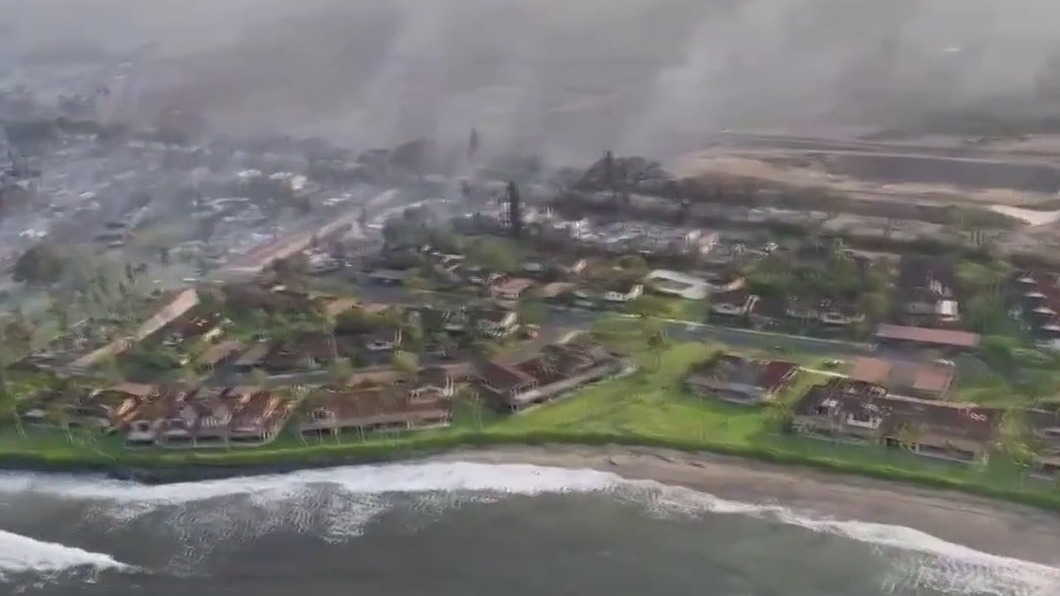High risks and lack of warnings in Maui lead to deadliest U.S. wildfire this century

High risks and lack of warnings in Maui lead to deadliest U.S. wildfire this century
Hawaii’s Attorney General will review Maui’s wildfire response following questions over preparedness, the island’s warning systems, and what officials knew about catastrophic fire risk.
OAKLAND, Calif. - Hawaii’s Attorney General will review Maui’s wildfire response following questions over preparedness, the island’s warning systems, and what officials knew about catastrophic fire risk.
Attorney General Anne Lopez will review how officials reacted to the fires that have killed nearly 100 people, charred more than 2,170 acres and destroyed nearly 2,200 homes and buildings.
People in the historic town of Lahaina described smelling smoke, seeing flames and running for their lives. Some of them jumped into the Pacific Ocean and treaded water for hours amid thick smoke, forceful winds and flying embers.
A cause of the fires that started last Tuesday has not yet been determined.
Maui County’s own reports show the risks were there and suggest that Hawaii and Maui’s fire problem is more extreme than on the U.S. mainland.
"If you just judge what could happen based on what has happening in the last year or two, or the last five years, you may drastically be underestimating your risk," said Professor LeRoy Westerling with UC Merced, who has extensively researched wildfire risk and climate change.
Major contributing factors include increased drought, rising temperatures and growing vegetation. Wildfire experts in Hawaii say nonnative and invasive grasses pose increased risks, primarily on abandoned, unmanaged or former plantation fields.
A 2020 hazard mitigation plan put together for Maui County says West Maui, including the historic town of Lahaina, had the highest probability for wildfires with more than a 90% chance annually.
Lahaina was leveled in the fires with nearly every building in the town of 13,000 destroyed. Gov. Josh Green said there’s at least $5.6 billion in damage.
The report states that between 1999 and 2019, there were 80 wildfires in west Maui amounting to an average of four fires a year.
"Dry, windy conditions with an accumulation of vegetative fuel can create conditions for a fire that spreads quickly," according to the mitigation plan reviewed by KTVU. "Wildfires could become more frequent in the future as drought conditions become more frequent and more intense with climate change."
Many survivors of the Maui fires said they never received alerts or warnings about the impending danger.
Maui officials admitted over the weekend that Hawaii’s highly touted warning system was not activated and sirens never sounded.
While they said some emergency text alerts were sent out, with electricity or telecommunications towers down, many messages were never received.
It’s strikingly similar to what happened amid recent California wildfires including the 2017 Wine Country fires and the 2018 Camp Fire that destroyed the town of Paradise and killed 85 people.
The fires in Maui are now the deadliest in U.S history in the last century.
But problems surrounding communications in the Bay Area are not limited to wildfires.
In San Francisco, the Outdoor Public Warning System was taken off-line in December 2019 due to security vulnerabilities, officials said Monday. Funding is not yet available to fix it.
Instead, the city is relying on residents to opt into mobile alerts or receive wireless warnings based on a person’s location.
Hawaii has had previous warning system missteps including sending out a false missile warning in 2018 that claimed "this is not a drill."
"We’re going to have to rethink our whole approach to this to move away from the mass media era of warning and toward something that can be a little more precise and a little more specific," said retired public warning specialist Art Botterell who previously worked for FEMA and CalOES. "People are going to have to realize that this is a problem that they individually and as neighborhoods and groups need to take on."
Botterell and other public warning experts say there’s going to be a shift to a commercial and community-based approach to alerts that cater to neighborhoods in a more immediate way."
Stream KTVU on your TV by downloading Fox Local on your Roku, Amazon Fire, AndroidTV or AppleTV device for free. More details here.
To compound issues in Maui, its mitigation plan said Lahaina and West Maui have the highest rate of non-English speakers and the second-highest rate of households without a car.
All of that may have added to the chaos and confusion as flames furiously claimed land and lives.
"This is a warning that things we didn’t expect could happen and are becoming much more likely to happen," Westerling said. "We have to start trying to anticipate with inadequate, incomplete information, imperfect models, the past not being a sure guide to the future."
Brooks Jarosz is an investigative reporter for KTVU. Email him at brooks.jarosz@fox.com and follow him on Facebook and Twitter @BrooksKTVU


